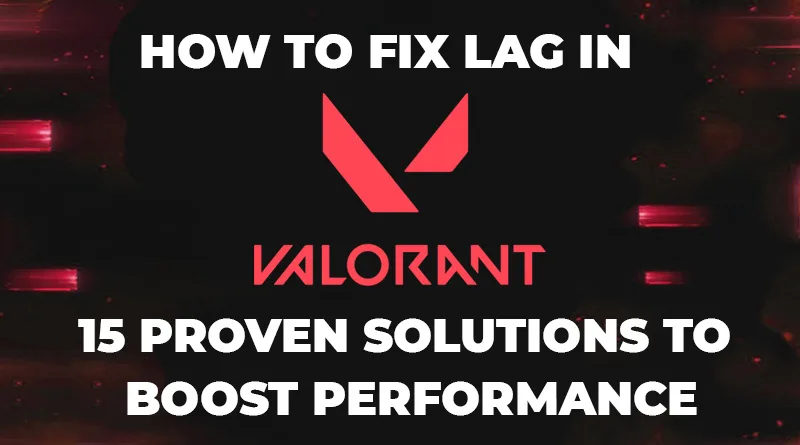If you’re a Valorant player who’s tired of lag ruining your clutch moments, you’re not alone. Lag can make even the most skilled players feel powerless, especially in a tactical shooter where milliseconds count.
In this guide, you’ll learn how to fix lag in Valorant using proven techniques — from in-game settings to system tweaks and network optimization. Whether you’re facing FPS drops, ping spikes, or stutters, we’ve got the solutions.
Table of Contents : How to Fix Lag in Valorant
- Understanding the Types of Lag in Valorant
- System Requirements for Smooth Valorant Gameplay
- Top Fixes for FPS Lag in Valorant
- Best Fixes for Network Lag in Valorant
- Advanced Tips to Fix Lag in Valorant
- Bonus: Tools and Software to Improve Performance
- Final Thoughts
Understanding the Types of Lag in Valorant
Before fixing lag, it’s important to know what type you’re dealing with:
1. FPS Lag (Low Frame Rate)
Occurs when your PC can’t render frames smoothly. It usually feels like stuttering or choppiness.
2. Network Lag (High Ping)
This is caused by internet issues — slow connection, packet loss, or server delay.
3. Input Lag
Delayed response from your mouse or keyboard actions, often related to system performance or graphics settings.
System Requirements for Smooth Valorant Gameplay
To eliminate lag in Valorant, your PC should meet or exceed the official specs:
Minimum Requirements:
- OS: Windows 7/8/10 64-bit
- CPU: Intel Core 2 Duo E8400
- RAM: 4GB
- GPU: Intel HD 3000
- VRAM: 1GB
Recommended Requirements:
- OS: Windows 10/11 64-bit
- CPU: Intel i3-4150
- RAM: 8GB+
- GPU: GTX 1050 Ti or better
👉 Tip: Always aim for 60+ FPS for smooth Valorant gameplay.
Top Fixes for FPS Lag in Valorant
1. Lower In-Game Graphics Settings
Go to Settings > Video and apply these:
- Material Quality: Low
- Texture Quality: Low
- UI Quality: Low
- Vignette: Off
- V-Sync: Off
- Anti-Aliasing: None
- Anisotropic Filtering: 1x
- Bloom, Distortion, Shadows: All Off
2. Update Your Graphics Drivers
Outdated drivers = low performance. Download the latest version from:
3. Enable High Performance Mode
Windows Settings > System > Power & Battery > Power Mode > High Performance
4. Close Background Applications
Use Task Manager (Ctrl+Shift+Esc) to close:
- Chrome
- Discord overlay
- Steam background apps
- Antivirus scans
5. Disable Fullscreen Optimization
Right-click the Valorant shortcut → Properties → Compatibility → Check “Disable fullscreen optimizations”
6. Clean Up Your PC
Use free tools like:
- CCleaner to clear junk
- MSI Afterburner to monitor temperature
- Windows Disk Cleanup
Best Fixes for Network Lag in Valorant
7. Use a Wired Ethernet Connection
Wi-Fi = unstable. Use an Ethernet cable for a direct and faster connection.
8. Choose the Right Valorant Server
In Valorant lobby:
Click your profile icon (top right) > Check your preferred server manually. Pick the one with the lowest ping.
9. Reset Your Router
Unplug for 10 seconds, then plug back in. Also, ensure no one is streaming Netflix or downloading large files during your matches.
10. Update Network Drivers
Just like GPU drivers, old network drivers can cause issues. Visit your motherboard or laptop manufacturer’s website to get the latest version.
11. Flush DNS Cache
Run this in Command Prompt (as Admin):
bashCopyEditipconfig /flushdns
Then restart your PC.
12. Use a Gaming VPN (Optional)
VPNs like ExitLag, NoPing, or WTFast can route your traffic better to reduce latency. Works especially well in regions with poor ISP routing.
Advanced Tips to Fix Lag in Valorant
13. Disable Game Mode (Windows 10/11)
Windows Game Mode can sometimes interfere with Valorant performance.
Go to:
Settings → Gaming → Game Mode → Toggle OFF
14. Set Valorant Priority to High
- Open Task Manager (Ctrl+Shift+Esc)
- Go to Details tab
- Right-click
VALORANT-Win64-Shipping.exe - Set priority → High
15. Optimize In-Game Sensitivity and DPI
Lag can feel worse with high mouse sensitivity. Try these:
- Lower DPI (400–800)
- Adjust in-game sensitivity to match
Bonus: Tools and Software to Improve Performance
| Tool | Purpose |
|---|---|
| Razer Cortex | Boosts FPS by closing unnecessary background processes |
| MSI Afterburner | Monitor temps and CPU/GPU usage |
| LatencyMon | Detects latency-causing drivers |
| Valorant Ping Test (3rd Party) | Shows the best region/server |
| Clean Boot Utility | Helps launch Windows with minimal services |
Final Thoughts
Lag in Valorant can stem from hardware limitations, internet issues, or system misconfigurations — but it’s almost always fixable. Try each of these 15 methods to improve your gameplay:
✅ Lower your in-game settings
✅ Update all drivers
✅ Use Ethernet over Wi-Fi
✅ Choose the right server
✅ Optimize your system and network
With these changes, you should see noticeable improvements in FPS, ping, and responsiveness — and finally start dominating those matches lag-free.
Frequently Asked Questions (FAQs)
Q1: Why is my Valorant lagging even with good internet?
It could be due to high background network usage, server issues, or system bottlenecks like CPU throttling.
Q2: What is the ideal ping for Valorant?
Anything below 40ms is considered great. 50–80ms is still playable. Above 100ms, you’ll start to notice delays.
Q3: Does Valorant support high refresh rate monitors?
Yes, Valorant supports up to 240Hz, and benefits from smoother refresh rates. Be sure to adjust refresh settings in both Windows and Valorant.

